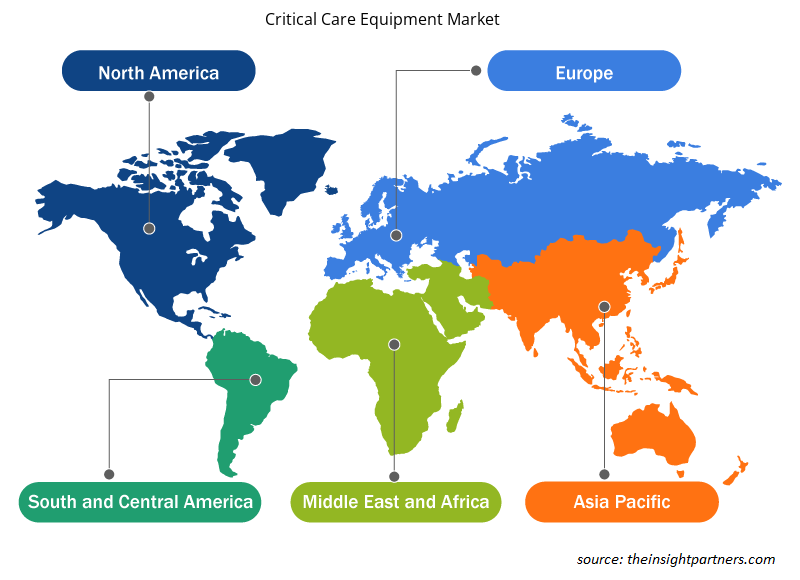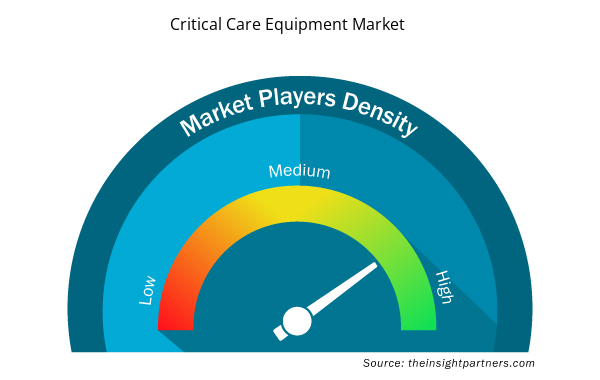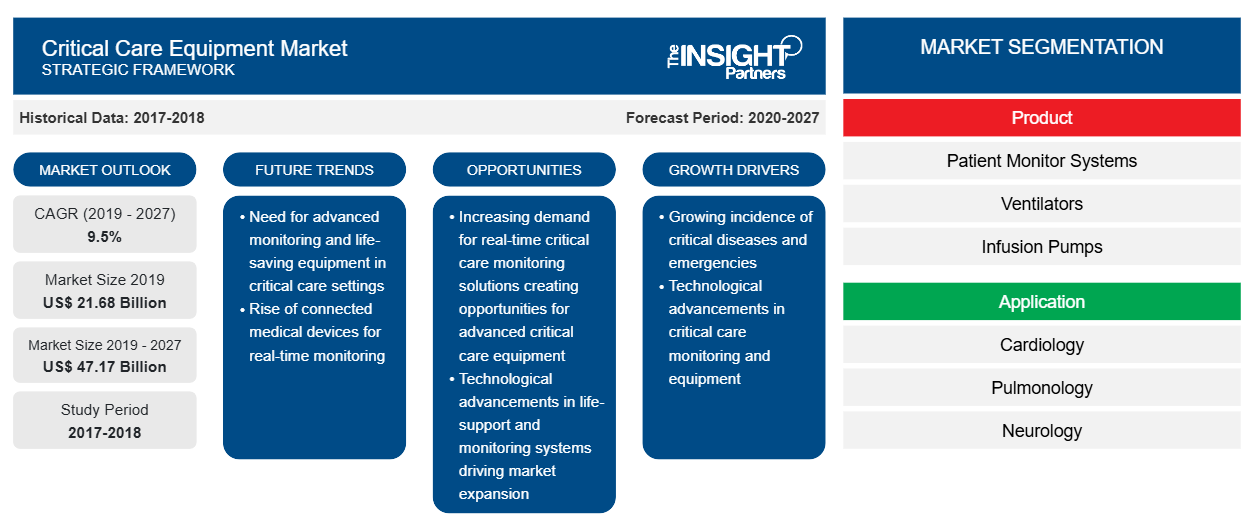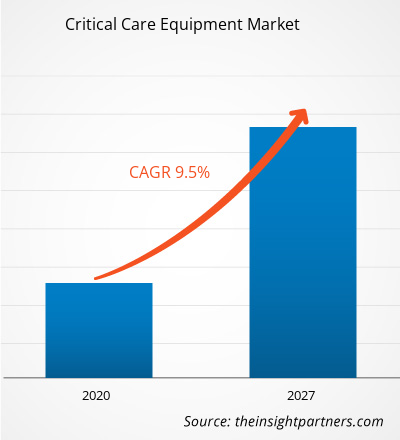Nel 2019, il mercato delle apparecchiature per terapia intensiva era valutato 21.682,65 milioni di dollari USA e si prevede che raggiungerà i 47.171,42 milioni di dollari USA entro il 2027; si prevede una crescita a un CAGR del 9,5% nel periodo 2020-2027.
I pazienti con l'infezione trascorrono in media 15 giorni in terapia intensiva. Secondo la Società Europea di Anestesiologia, il numero di posti letto in terapia intensiva in Italia continua a crescere. In Lombardia, prima della diffusione del coronavirus, c'erano 140 posti letto in terapia intensiva privata e 500 posti letto in terapia intensiva pubblica, che sono aumentati a più di 900 entro la fine di marzo 2020.
Personalizza questo report in base alle tue esigenze
Riceverai la personalizzazione gratuita di qualsiasi report, comprese parti di questo report, o analisi a livello nazionale, pacchetto dati Excel, oltre a usufruire di grandi offerte e sconti per start-up e università
- Scopri le principali tendenze di mercato in questo rapporto.Questo campione GRATUITO includerà analisi di dati che spaziano dalle tendenze di mercato alle stime e alle previsioni.
Approfondimenti di mercato
Crescente numero di posti letto in terapia intensiva nei paesi con elevata prevalenza di COVID-19 per guidare la crescita del mercato
Il COVID-19 è stato dichiarato pandemia globale dall'Organizzazione Mondiale della Sanità l'11 marzo 2020. Questa nuova malattia è caratterizzata da un numero inferiore di casi iniziali seguito da un'esplosione di infezioni in vari paesi. Nonostante l'implementazione di lockdown per ridurre la diffusione del COVID-19, i sistemi sanitari di vari paesi sono stati sopraffatti dalla domanda di attrezzature, come letti in terapia intensiva e attrezzature di supporto per curare casi gravi di malattia.
Approfondimenti sui prodotti
In termini di prodotto, il segmento dei sistemi di monitoraggio dei pazienti ha detenuto la quota maggiore del mercato nel 2019 e si prevede che continuerà a essere un azionista leader durante il periodo di previsione. Tuttavia, si prevede che il segmento dei ventilatori registrerà un CAGR più elevato nel mercato durante il periodo di previsione.
Approfondimenti sulle applicazioni
In base all'applicazione, il mercato globale delle apparecchiature di terapia intensiva è segmentato in cardiologia, pneumologia, neurologia, ortopedia e altri. Il segmento cardiologico ha detenuto la quota maggiore del mercato nel 2019 e si prevede che il segmento pneumologico registrerà il CAGR più elevato durante il periodo di previsione. La terapia intensiva cardiovascolare è la gestione sistemica dei pazienti con gravi malattie cardiovascolari (CVD), tra cui malattie vascolari e cardiache. Le CVD sono tra le principali cause di morte in tutto il mondo. Ad esempio, secondo l'Organizzazione mondiale della sanità, nel 2016, circa 17,9 milioni di persone sono morte per CVD, rappresentando il 31% dei decessi in tutto il mondo. Allo stesso modo, secondo i Centers for Diseases Control and Prevention, circa 655.000 americani muoiono ogni anno per malattie cardiache. Per prevenire i decessi dovuti a CVD, negli ospedali generali è disponibile un'unità di terapia intensiva per pazienti con gravi malattie cardiovascolari, ovvero l'unità di terapia intensiva cardiovascolare (CICU). Gli sviluppi tecnologici della cardiologia clinica, come le procedure e i dispositivi interventistici intracoronarici e il monitoraggio emodinamico invasivo, sono le principali evoluzioni della terapia intensiva per le malattie cardiovascolari. Di conseguenza, il numero di pazienti con malattie cardiovascolari gravi ricoverati in CICU cresce ogni anno. I pazienti in CICU hanno molte complicazioni come insufficienza respiratoria e insufficienza renale. Pertanto, è richiesto personale medico qualificato per praticare la terapia intensiva sistemica.
Si prevede che le collaborazioni e le partnership tecnologiche tra gli attori del mercato delle apparecchiature per terapia intensiva per colmare il divario tra domanda e offerta svolgeranno un ruolo significativo nella crescita del mercato durante il periodo di previsione.
Approfondimenti regionali sul mercato delle attrezzature per terapia intensiva
Le tendenze regionali e i fattori che influenzano il mercato delle apparecchiature per terapia intensiva durante il periodo di previsione sono stati ampiamente spiegati dagli analisti di Insight Partners. Questa sezione discute anche i segmenti e la geografia del mercato delle apparecchiature per terapia intensiva in Nord America, Europa, Asia Pacifico, Medio Oriente e Africa e America meridionale e centrale.

- Ottieni i dati specifici regionali per il mercato delle apparecchiature di terapia intensiva
Ambito del rapporto sul mercato delle attrezzature per terapia intensiva
| Attributo del report | Dettagli |
|---|---|
| Dimensioni del mercato nel 2019 | 21,68 miliardi di dollari USA |
| Dimensioni del mercato entro il 2027 | 47,17 miliardi di dollari USA |
| CAGR globale (2019 - 2027) | 9,5% |
| Dati storici | 2017-2018 |
| Periodo di previsione | 2020-2027 |
| Segmenti coperti | Per Prodotto
|
| Regioni e Paesi coperti | America del Nord
|
| Leader di mercato e profili aziendali chiave |
|
Densità degli operatori del mercato delle apparecchiature per terapia intensiva: comprendere il suo impatto sulle dinamiche aziendali
Il mercato delle apparecchiature per terapia intensiva sta crescendo rapidamente, spinto dalla crescente domanda degli utenti finali dovuta a fattori quali l'evoluzione delle preferenze dei consumatori, i progressi tecnologici e una maggiore consapevolezza dei vantaggi del prodotto. Con l'aumento della domanda, le aziende stanno ampliando le loro offerte, innovando per soddisfare le esigenze dei consumatori e capitalizzando sulle tendenze emergenti, il che alimenta ulteriormente la crescita del mercato.
La densità degli operatori di mercato si riferisce alla distribuzione di aziende o società che operano in un particolare mercato o settore. Indica quanti concorrenti (operatori di mercato) sono presenti in un dato spazio di mercato in relazione alle sue dimensioni o al valore di mercato totale.
Le principali aziende che operano nel mercato delle apparecchiature per terapia intensiva sono:
- Compagnia elettrica generale
- Medtronic
- B. Braun Melsungen AG
- Baxter International Inc.
- Koninklijke Philips NV
Disclaimer : le aziende elencate sopra non sono classificate secondo un ordine particolare.

- Ottieni una panoramica dei principali attori del mercato delle attrezzature per terapia intensiva
Per Prodotto
- Sistemi di monitoraggio dei pazienti
- Ventilatori
- Ventilatori invasivi
- Ventilatori non invasivi
- Pompe per infusione
- Altri
Per applicazione
- Cardiologia
- Pneumologia
- Neurologia
- Ortopedico
- Altri
Per utente finale
- Ospedali
- Centri di assistenza ambulatoriale
- Assistenza domiciliare
- Altri
Per Geografia
- America del Nord
- NOI
- Canada
- Messico
- Europa
- Francia
- Germania
- Italia
- Regno Unito
- Russia
- Asia Pacifico (APAC)
- Cina
- India
- Corea del Sud
- Giappone
- Australia
- Medio Oriente e Africa (MEA)
- Sudafrica
- Arabia Saudita
- Emirati Arabi Uniti
- America del Sud e Centro (SCAM)
- Brasile
- Argentina
Profili aziendali
- Compagnia elettrica generale
- Medtronic
- B. Braun Melsungen AG
- Baxter International Inc.
- Koninklijke Philips NV
- Azienda
- Hamilton Medico
- Löwenstein Medical UK Ltd.
- Società per azioni Dragerwerk AG & Co. KGaA
- Società Nihon Kohden
- Società controllata da Fisher & Paykel Healthcare Limited.
- Azienda: Shenzhen Mindray Biomedical Electronics Co., Ltd.
- BPL
- Assistenza sanitaria Trivitron
- TECNOLOGIE SKANRAY PVT LTD
- Società Asahi Kasei
- Analisi storica (2 anni), anno base, previsione (7 anni) con CAGR
- Analisi PEST e SWOT
- Valore/volume delle dimensioni del mercato - Globale, regionale, nazionale
- Industria e panorama competitivo
- Set di dati Excel


- Advanced Planning and Scheduling Software Market
- Health Economics and Outcome Research (HEOR) Services Market
- Educational Furniture Market
- Data Center Cooling Market
- Vision Guided Robotics Software Market
- Latent TB Detection Market
- Nuclear Waste Management System Market
- Lymphedema Treatment Market
- Radiopharmaceuticals Market
- Wheat Protein Market

Report Coverage
Revenue forecast, Company Analysis, Industry landscape, Growth factors, and Trends

Segment Covered
This text is related
to segments covered.

Regional Scope
North America, Europe, Asia Pacific, Middle East & Africa, South & Central America

Country Scope
This text is related
to country scope.
Domande frequenti
The disruption of supply chain and logistics due to the rapid spread of COVID-19 is the significant factor that will hinder the critical care equipment market growth.
The global critical care equipment market is being driven by factors such growing number of ICU beds in countries with a high prevalence of COVID-19 and increasing demand for ventilators for the effective management of critical COVID-19 patients. Furthermore, technological innovations in critical care equipment is likely to offer significant opportunities for the growth of the global critical care equipment market.
Critical care equipment includes cardiac support, patient monitoring, respiratory support, emergency resuscitation devices, pain management, and other life support equipment designed to care for critically ill patients or have undergone a major surgical procedure, thereby requiring 24-hour care monitoring.
Trends and growth analysis reports related to Life Sciences : READ MORE..
The List of Companies - Critical Care Equipment Market
- General Electric Company
- Medtronic
- B. Braun Melsungen AG
- Baxter International Inc.
- Koninklijke Philips N.V.
- Getinge AB
- Hamilton Medical
- Löwenstein Medical UK Ltd.
- Dragerwerk AG & Co. KGaA
- Nihon Kohden Corporation
- Fisher & Paykel Healthcare Limited.
- Shenzhen Mindray Biomedical Electronics Co., Ltd.
- BPL
- Trivitron Healthcare
- Skanray Technologies Pvt Ltd
- Asahi Kasei Corporation
The Insight Partners performs research in 4 major stages: Data Collection & Secondary Research, Primary Research, Data Analysis and Data Triangulation & Final Review.
- Data Collection and Secondary Research:
As a market research and consulting firm operating from a decade, we have published and advised several client across the globe. First step for any study will start with an assessment of currently available data and insights from existing reports. Further, historical and current market information is collected from Investor Presentations, Annual Reports, SEC Filings, etc., and other information related to company’s performance and market positioning are gathered from Paid Databases (Factiva, Hoovers, and Reuters) and various other publications available in public domain.
Several associations trade associates, technical forums, institutes, societies and organization are accessed to gain technical as well as market related insights through their publications such as research papers, blogs and press releases related to the studies are referred to get cues about the market. Further, white papers, journals, magazines, and other news articles published in last 3 years are scrutinized and analyzed to understand the current market trends.
- Primary Research:
The primarily interview analysis comprise of data obtained from industry participants interview and answers to survey questions gathered by in-house primary team.
For primary research, interviews are conducted with industry experts/CEOs/Marketing Managers/VPs/Subject Matter Experts from both demand and supply side to get a 360-degree view of the market. The primary team conducts several interviews based on the complexity of the markets to understand the various market trends and dynamics which makes research more credible and precise.
A typical research interview fulfils the following functions:
- Provides first-hand information on the market size, market trends, growth trends, competitive landscape, and outlook
- Validates and strengthens in-house secondary research findings
- Develops the analysis team’s expertise and market understanding
Primary research involves email interactions and telephone interviews for each market, category, segment, and sub-segment across geographies. The participants who typically take part in such a process include, but are not limited to:
- Industry participants: VPs, business development managers, market intelligence managers and national sales managers
- Outside experts: Valuation experts, research analysts and key opinion leaders specializing in the electronics and semiconductor industry.
Below is the breakup of our primary respondents by company, designation, and region:

Once we receive the confirmation from primary research sources or primary respondents, we finalize the base year market estimation and forecast the data as per the macroeconomic and microeconomic factors assessed during data collection.
- Data Analysis:
Once data is validated through both secondary as well as primary respondents, we finalize the market estimations by hypothesis formulation and factor analysis at regional and country level.
- Macro-Economic Factor Analysis:
We analyse macroeconomic indicators such the gross domestic product (GDP), increase in the demand for goods and services across industries, technological advancement, regional economic growth, governmental policies, the influence of COVID-19, PEST analysis, and other aspects. This analysis aids in setting benchmarks for various nations/regions and approximating market splits. Additionally, the general trend of the aforementioned components aid in determining the market's development possibilities.
- Country Level Data:
Various factors that are especially aligned to the country are taken into account to determine the market size for a certain area and country, including the presence of vendors, such as headquarters and offices, the country's GDP, demand patterns, and industry growth. To comprehend the market dynamics for the nation, a number of growth variables, inhibitors, application areas, and current market trends are researched. The aforementioned elements aid in determining the country's overall market's growth potential.
- Company Profile:
The “Table of Contents” is formulated by listing and analyzing more than 25 - 30 companies operating in the market ecosystem across geographies. However, we profile only 10 companies as a standard practice in our syndicate reports. These 10 companies comprise leading, emerging, and regional players. Nonetheless, our analysis is not restricted to the 10 listed companies, we also analyze other companies present in the market to develop a holistic view and understand the prevailing trends. The “Company Profiles” section in the report covers key facts, business description, products & services, financial information, SWOT analysis, and key developments. The financial information presented is extracted from the annual reports and official documents of the publicly listed companies. Upon collecting the information for the sections of respective companies, we verify them via various primary sources and then compile the data in respective company profiles. The company level information helps us in deriving the base number as well as in forecasting the market size.
- Developing Base Number:
Aggregation of sales statistics (2020-2022) and macro-economic factor, and other secondary and primary research insights are utilized to arrive at base number and related market shares for 2022. The data gaps are identified in this step and relevant market data is analyzed, collected from paid primary interviews or databases. On finalizing the base year market size, forecasts are developed on the basis of macro-economic, industry and market growth factors and company level analysis.
- Data Triangulation and Final Review:
The market findings and base year market size calculations are validated from supply as well as demand side. Demand side validations are based on macro-economic factor analysis and benchmarks for respective regions and countries. In case of supply side validations, revenues of major companies are estimated (in case not available) based on industry benchmark, approximate number of employees, product portfolio, and primary interviews revenues are gathered. Further revenue from target product/service segment is assessed to avoid overshooting of market statistics. In case of heavy deviations between supply and demand side values, all thes steps are repeated to achieve synchronization.
We follow an iterative model, wherein we share our research findings with Subject Matter Experts (SME’s) and Key Opinion Leaders (KOLs) until consensus view of the market is not formulated – this model negates any drastic deviation in the opinions of experts. Only validated and universally acceptable research findings are quoted in our reports.
We have important check points that we use to validate our research findings – which we call – data triangulation, where we validate the information, we generate from secondary sources with primary interviews and then we re-validate with our internal data bases and Subject matter experts. This comprehensive model enables us to deliver high quality, reliable data in shortest possible time.


 Ottieni un campione gratuito per questo repot
Ottieni un campione gratuito per questo repot